Text

Walmart Product Data Scraping Services for eCommerce InsightsiWeb Scraping Services delivers efficient Walmart product data scraping services to help eCommerce firms acquire structured and proper product information. Extract pricing, stock levels, and additional data from Walmart’s platform to optimize pricing strategies, improve product listings, and stay ahead of competitors. Our Walmart product data extraction services are developed for high-volume scraping with clean and ready-to-integrate outputs. Companies can access real-time updates, maintain catalog consistency, and analyze competitor offerings at scale. With a priority on speed, accuracy, and reliability, we simplify your access to Walmart’s vast product ecosystem. Whether you're tracking SKU changes, seasonal price changes, or customer sentiment, our scraping solutions are built to meet your dynamic retail markets. iWeb Scraping Services provides you with data-ready Walmart product Data scraping that support smarter business decisions through automation and structured feeds.
0 notes
Text

Access Verified Amazon Seller Database India for Business Growth
iWeb Scraping provides verified Amazon Seller Database India to help businesses access seller contact details, product categories, ratings, pricing, and seller performance data. This service is ideal for B2B marketing, lead generation, seller analysis, and market segmentation. The data is collected using advanced scraping technology, ensuring clean and structured information from the Amazon India marketplace. Businesses can use this data to build prospect lists, understand seller competition, or enhance their product sourcing strategy. With features like real-time extraction, geo-targeting, and seamless data delivery in CSV, Excel, or JSON, the service ensures reliability and usability at scale. Whether you're a manufacturer, distributor, or digital marketer, this dataset can support multiple use cases. iWeb Scraping’s infrastructure ensures secure extraction and consistent output without delays.
0 notes
Text

Product Scraping Services for Accurate and Scalable Data Extraction iWeb Scraping Services offers reliable Product Scraping Services to help businesses extract Amazon product data with speed and accuracy. As a trusted product scraping company, we deliver detailed insights including pricing, reviews, ratings, ASINs, availability, and more. Our advanced scraping infrastructure ensures consistent access to large-scale product listings, helping retailers, analysts, and eCommerce platforms stay ahead of their competitors. Whether you're tracking competitors or updating inventory databases, our service supports real-time data extraction while maintaining high standards for structure and clarity. With iWeb Scraping Services, access product-level intelligence that drives smarter decisions. From product descriptions to category-level data, we handle every detail to help streamline your operations. Choose a product scraping company that understands scale, performance, and reliability. Partner with iWeb Scraping Services to access consistent and structured Amazon product data with ease.
0 notes
Text
Scrape Youtube Subscribers Data Using Smart Automation Tools

Our scraping tools can collect subscriber counts, video stats, channel descriptions, and engagement metrics across thousands of channels. scrape YouTube subscribers and extract accurate channel data in real time. Businesses and analysts can use this data to research influencers, keep candidates, or build targeted marketing lists. With a focus on precision and speed, we ensure consistent access to high-quality insights. Whether you're analyzing content performance or tracking subscriber growth, our services make it easier to extract what matters. Scrape Youtube subscribers efficiently and at scale with appliances that support your research and outreach goals. All data is given in easy-to-analyze formats such as CSV or Excel, allowing units gain quick visibility and actionable findings. Partner with iWeb Scraping Services to power your data processes with real-time, reliable YouTube channel brains.
1 note
·
View note
Text

Grocery Data Scraping Services for Real-Time Retail Insights iWeb Scraping Services provides reliable Grocery Data Scraping Services to extract real-time development, pricing, and availability data from leading grocery platforms. As a trusted grocery data scraping company, we support retail companies, data reviewers, and eCommerce platforms in accessing structured grocery datasets for competitive analysis, assortment planning, trend monitoring, and shelf intelligence. Our team extracts data on brand listings, nutritional points, pricing changes, value practices, and inventory updates from leading online grocery stores and apps. Businesses can create smarter pricing decisions, optimize effective offerings, and follow competitor movements efficiently. We focus on delivering high-quality, scalable datasets in desired forms including Excel, CSV, or JSON, for easy integration into BI dashboards and analytics tools. Whether you're targeting local supermarkets or multinational grocery chains, our scraping solutions adapt to your specific data needs. Leverage grocery insights to respond faster to need changes and drive smarter conclusions with actionable data from iWeb Scraping Services, your trusted Grocery Data Scraping Company.
0 notes
Text

Costco API Data Scraping Services for Retail Intelligence Needs
Costco API solutions for businesses looking to extract accurate product, inventory, and pricing data from Costco.Our API integration ensures fast access to structured data in real-time, enabling smarter retail decisions and competitive benchmarking. Whether you’re scanning market shifts or searching product availability, our Costco API helps facilitate your data channels with minimal effort. iWeb Scraping Services proposes reliable extraction of data from considerable categories, including electronics, furniture, appliances, and more. With a scalable architecture and automated updates, our scraping API handles regular changes on retailer websites without disruption. Businesses can count on our service to deliver clean, ready-to-use data that supports analytics, catalog enrichment, and pricing intelligence. iWeb Scraping Services ensures consistent support, high performance, and flexible formats tailored to your systems. Gain access to enriched datasets and maintain a competitive edge in the retail e-commerce space through our seamless Costco API integration.
0 notes
Text
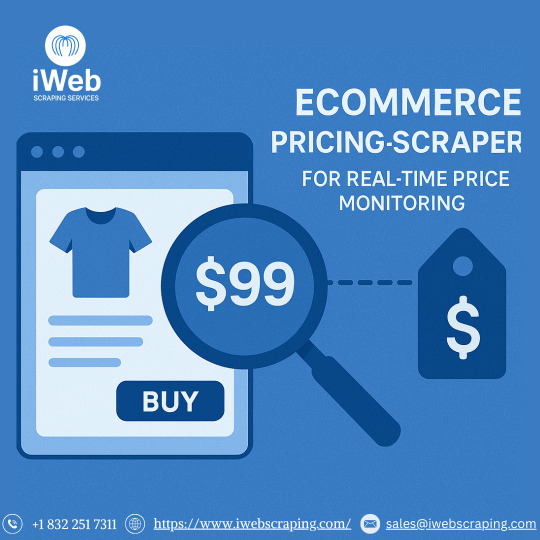
E-commerce Pricing Scraper for Real-Time Price Monitoring
iWeb Scraping Services offers e-commerce pricing scraper solutions to help businesses track real-time price changes, monitor competitor strategies, and extract structured product data at scale. Our e-commerce pricing data scraper enables accurate pricing analysis across multiple online stores, boosting strategic planning and revenue management. Get updated data feeds without technical hassles.
0 notes
Text
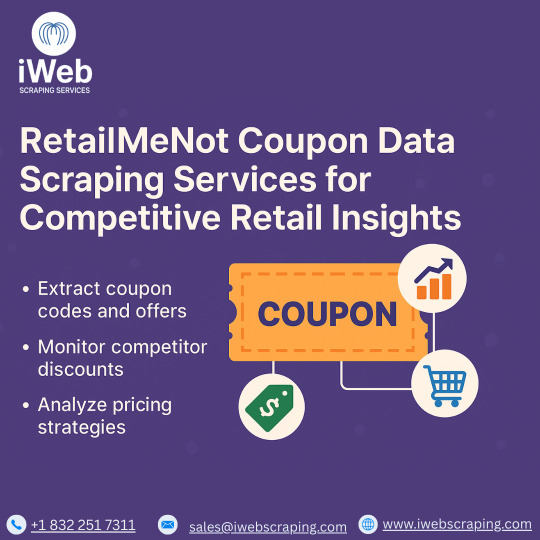
RetailMeNot Coupon Data Scraping Services for Competitive Retail Insights
Access structured coupon and promo code data from RetailMeNot using reliable scraping. collect Data like discount coupon types, brand percentages, expiration dates, categories, and user ratings. With clean, organized datasets, businesses can monitor competitor offers, analyze pricing strategies, and track seasonal deal trends effectively.
RetailMeNot coupon data scraping allows e-commerce platforms, deal aggregators, and digital marketing firms to stay revised with real-time retail intelligence. Specify which brands offer frequent discounts, understand average savings per category, and gather data for targeted campaigns or dynamic pricing models. Coupon data scraping allows e-commerce platforms, deal aggregators, and digital marketing firms to stay revised with real-time retail intelligence. Specify which brands offer frequent discounts, understand average savings per category, and gather data for targeted campaigns or dynamic pricing models.
0 notes
Text
Restaurant Menu Scraping Services—Extract Food Menu Data
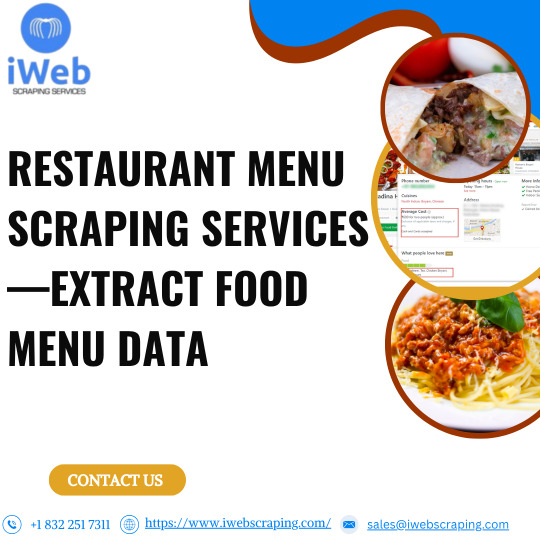
Access detailed restaurant menu data effortlessly with our professional restaurant menu scraping services. Whether you’re building a food delivery app, conducting market research, or managing a restaurant aggregator platform, we help extract structured data directly from restaurant websites. Gather essential information such as dish names, ingredients, pricing, dietary tags, categories, and images — all in a clean, ready-to-use format.
Our automated solutions ensure accurate data collection across thousands of listings, helping you keep menus updated with the latest entries and pricing. From multi-location franchises to local diners, our scraping service supports a wide variety of restaurant platforms. With real-time updates and reliable output formats like CSV, JSON, or Excel, your team can make smarter decisions, faster.
Leverage data to track food trends, analyze competitors, or enhance your digital menu offerings with precision. iWeb scraping ensures secure and efficient extraction — no manual effort needed. Scale your food-related operations confidently with structured, reliable restaurant menu data.
0 notes
Text

eCommerce Data Scraping Services for Product, Price & Review Monitoring
Product research and pricing analysis with professional eCommerce data scraping services from iWeb Scraping. We support companies collect real-time & trustworthy data from marketplaces to stay ahead of trends and competitors. Capture detailed insights, including product names, categories, pricing, ratings, reviews, stock availability, and seller data, across various e-commerce platforms.
0 notes
Text
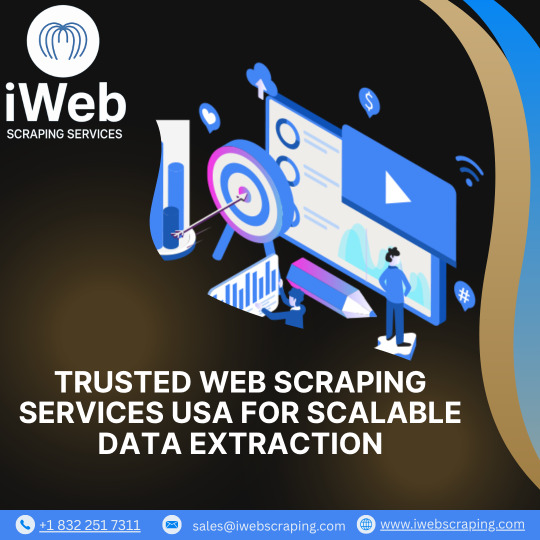
Trusted Web Scraping Services USA for Scalable Data Extraction
iWeb Scraping is an efficient web scraping services used to manage large-scale, structured data from websites & APIs across different industries. Various platform helps companies collect crucial data like product details, pricing, reviews, Product Listing, stock levels, location data, job listings, and more. Whether for competitor analysis, lead generation, or price tracking, iWeb Scraping supports data extraction from e-commerce, travel, automotive, real estate, and financial platforms. With components like automated scheduling, CAPTCHA handling, and geo-based IP rotation, the services are built to ensure speed, accuracy, and reliability. Data is provided in formats including CSV, Excel, JSON, or through API integration based on user selection. iWeb Scraping helps companies save time and reduce manual effort by delivering automated, scalable scraping infrastructure.
0 notes
Text
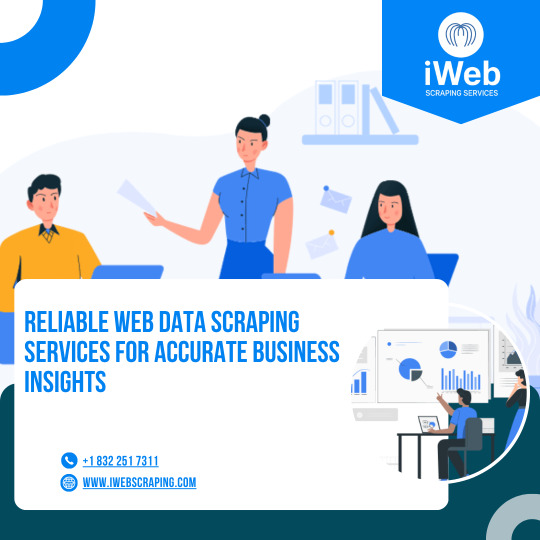
Reliable Web Data Scraping Services for Accurate Business Insights
Access up-to-date, organized data with iWeb Scraping’s reliable web data scraping services. From product catalogs and pricing details to client feedback and vendor information, companies can collect essential data from e-commerce websites, travel directories, real estate portals, job listings, financial networks, automotive sources, and more. iWeb scraping provides clean, scalable, reliable, and customizable data solutions to support analytics, competitor tracking, and decision-making processes. Whether for market research, price monitoring, or lead generation, our scraping infrastructure supports large-scale extraction with speed and accuracy. Data structures are provided as per your need—Excel, CSV, JSON, or APIs. The platform also offers IP rotation, geo-targeting, and CAPTCHA handling for uninterrupted delivery. With iWeb Scraping, businesses can automate data collection while maintaining accuracy and reliability across various digital sources. To know more about how your business can benefit from efficient data scraping, visit https://www.iwebscraping.com/. Get the data that drives smarter decisions—on time and at scale.
0 notes
Text
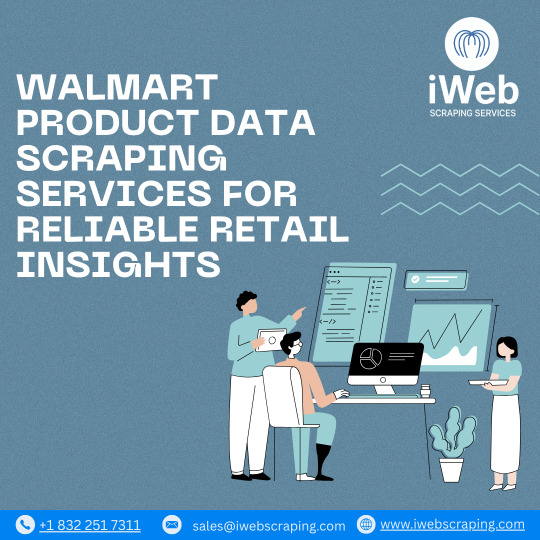
Walmart Product Data Scraping Services for Reliable Retail Insights
Access real and structured retail data with our Walmart product data scraping services. iWeb Scraping allows businesses to extract key product data, including pricing, stock availability, product reports, and reviews, directly from Walmart’s listings. Whether you need real-time data or scheduled extractions, our solutions support bulk data scraping with high accuracy and speed. This advantage is ideal for e-commerce analytics, competitor research, dynamic pricing models, and marketplace performance tracking.
To research scalable Walmart scraping services that simplify access to valuable product intelligence. Stay updated and competitive by integrating accurate Walmart data into your internal systems.
0 notes
Text
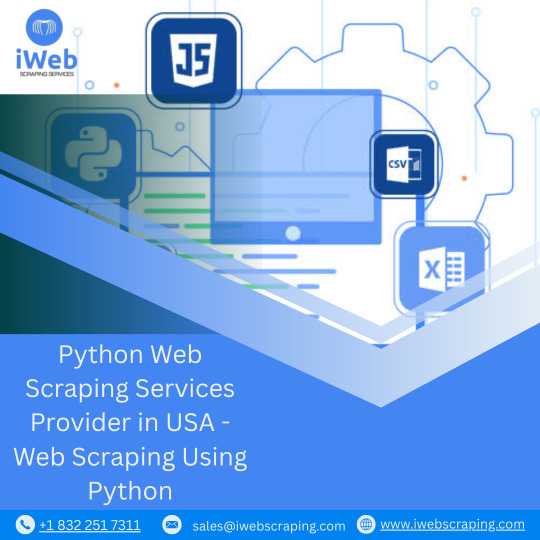
Python Web Scraping Services Provider in USA - Web Scraping Using Python
You’ve perhaps heard about how enormous Python is. However, other programming languages are also excellent, so why should you choose Python for web data scraping over the other languages? So, here is the list of Python features that make it more appropriate for web scraping.
Have you heard about Python web scraping and what it does for you? Web scraping with Python is a method for collecting data from webpages using Python technology. It does the routine task of searching and downloading pages or collecting content and storing it in a particular data format. iWeb Scraping provides the best web scraping and data mining services provider in the USA using Python technology that makes your task of scraping the website quickly easy.
You’ve perhaps heard about how enormous Python is. However, other programming languages are also excellent, so why should you choose Python for web scraping over the other languages? So, here is the list of Python features that make it more appropriate for web scraping.
0 notes
Text
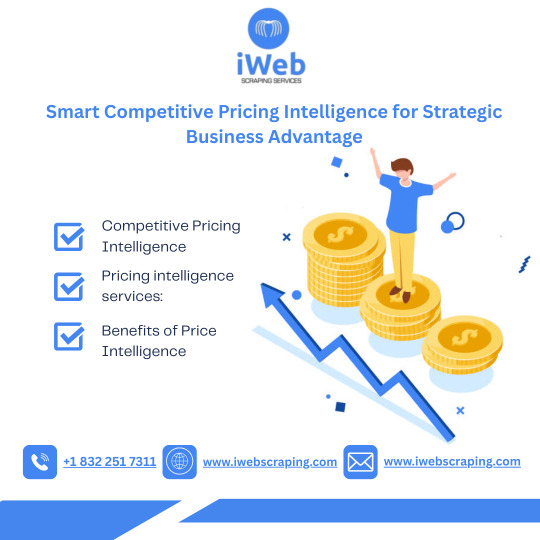
Smart Competitive Pricing Intelligence for Strategic Business Advantage
iweb scraping services Competitive pricing intelligence gives businesses permission to remain up-to-date with market changes through monitoring competitor pricing in real time. This gives business permission to follow trends, factor in gaps in pricing, and modify offers according to information-based strategies rather than hypotheses.Whether in e-commerce, retail, or manufacturing, using precise pricing intelligence supports wiser decision-making. Pricing intelligence is critical since retail pricing is competitive, rapid, and changing wherein correct or incorrect prices directly affect profitability and sales.
0 notes
Text

E-commerce Web Scraping API for Accurate Product & Pricing Insights
Access structured e-commerce data efficiently with a robust web scraping API for online stores, marketplaces, and retail platforms. This API helps collect data on product listings, prices, reviews, stock availability, and seller details from top e-commerce sites. Ideal for businesses monitoring competitors, following trends, or managing records, it provides consistent and correct results. Built to scale, the service supports high-volume requests and delivers results in easy-to-integrate formats like JSON or CSV. Whether you need data from Amazon, eBay, or Walmart. iWeb Scraping provides unique e-commerce data scraping services. Learn more about the service components and pricing by visiting iWebScraping E-commerce Data Services.
0 notes
Text
0 notes